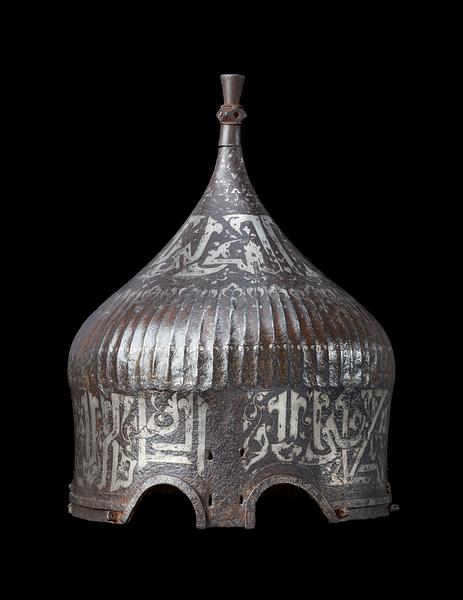Helmet of engraved and punched steel overlaid with silver and with traces of gilding
Western Iran or Eastern Anatolia; last quarter of the 15th century
H: 32.5; Diam: 25.5 cm
Helmets of this type are called ‘turban helmets’, either because they were worn over a shock-absorbing turban or because their domed shape resembles such headwear. In the late fifteenth century, the type was especially widespread among the Turkmen tribes in Iran and Anatolia, and turban helmets appear in several miniatures from the Turkmen so-called
Big Head Shahnama from 1494 (
42/2006,
44/2006).
An aventail (protective chain mail) would originally have been attached along the bottom edge, and the four holes at the front would have held a nasal. The funnel-shaped finial is intended to hold a plume or a flag. The tip and dome are adorned with foliage and meandering arabesques. Above and below the dome are two broad bands with Arabic inscriptions written in floral eastern
Kufi script. Furthermore, the bands along the rim are densely covered in pseudo-calligraphy. The decorations have been created by means of engraving and the
koftgari technique, where a thin layer of silver is rubbed or hammered onto the scratched surface. Remains of gilding can also be seen in some places along the bottom edge of the helmet.
The inscriptions on the helmet praise an unnamed ruler with a range of glorious titles also known from other helmets made in Anatolia in the second half of the fifteenth century.
[1] The arabesque designs are typical of the period’s Turkmen metalwork, and closely related motifs adorn the rim of an oil lamp commissioned by the leader of the Aq Qoyunlu Turkmen, Uzun Hasan, around 1470 (
45/1999).
Above the left semi-circular opening for the eye is a small, circular engraved mark (
tamgha), which shows that the helmet has been part of the Ottoman Hagia Eirene arsenal in Istanbul, probably as booty.
Inv. no. 37/2017
Published in:
Hotel Drout, Paris, 14/3-1952, lot 67, pl. III 67;
Jean Soustiel and Marie-Christine David (eds.): Art Ottoman: centenaire de la Maison Soustiel 1883-1983, Paris 1984, pp. 20-21;
Howard Ricketts and Philippe Missillier (eds.): Splendeur des Armes Orientales, ACTE-EXPO, Galerie Art 4, esplanade de la Défense, Paris, 4 May – 31 July 1988, Paris 1988, cat. 9, pp. 20-21;
Kjeld von Folsach, Joachim Meyer and Peter Wandel: Fighting, Hunting, Impressing: Arms and Armour from the Islamic World 1500–1850, The David Collection, Copenhagen, cat. 61 and Appendix,, p. 277 + fig. 7, p. 30;
Filiz Cakir Phillip: “Weaponry of Iran in the 15th and 16th centuries. A helmet and a spearhead in the David Collection” in Journal of the David Collection, 2021, 5, pp. 80-95;
Joachim Meyer, Rasmus Bech Olsen and Peter Wandel: Beyond words: calligraphy from the World of Islam, The David Collection, Copenhagen 2024, cat. 100, pp. 260-261;
